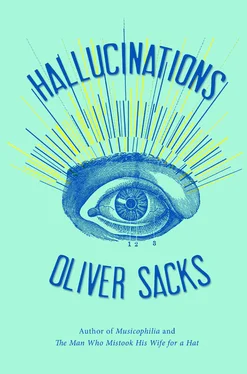Marlon S., in his late seventies, has progressive glaucoma and some mild dementia. He has been unable to read for the last twenty years, and for the last five years has been virtually blind. He is a devout Christian and still works as a lay minister in prisons, as he has done for the last thirty years. He lives alone in an apartment, but he leads a very active social life. He goes out each day, either with one of his children or with a home attendant, to family occasions or to the senior center, where there may be games, dancing, going out to restaurants, and other activities.
Although he is blind, Marlon seems to inhabit a world that is very visual and sometimes very strange. He tells me that he often “sees” his surroundings — he has lived most of his life in the Bronx, but what he sees is an ugly, desolate version of the Bronx (he describes it as “shabby, old, much older than me”), and this may give him a feeling of disorientation. He “sees” his apartment, but he can easily get lost or confused. Sometimes, he says, the apartment gets “as big as a Greyhound bus terminal,” and at other times it contracts, becoming “as skinny as a railroad apartment.” In general, the hallucinated apartment looks dilapidated and chaotic: “My whole house is a wreck, looks like the Third World … then it looks regular.” (The only time his apartment actually is a mess, his daughter told me, is when Marlon, thinking that he is “blockaded” by the furniture, starts rearranging it, pushing things to and fro.)
His hallucinations started about five years ago and were at first benign. “In the beginning,” he told me, “I saw a lot of animals.” They were followed by hallucinations of children — multitudes of them, just as there would always be multitudes of animals. “All of a sudden,” Marlon remembered, “I see all these kids come in, they were walking all around; I thought they were regular kids.” The children were silent but “talked with their hands”; they seemed unconscious of him and “did their own thing” — walking around, playing. He was startled when he found that no one else saw them. It was only then that he realized that his “eyes were playing tricks” on him.
Marlon enjoys listening to talk shows, gospel, and jazz on the radio, and when he does so, he may find his sitting room crowded with hallucinatory people who are also listening. Sometimes their mouths move as if they are speaking or singing along with the radio. These visions are not unpleasant, and they seem to provide a sort of hallucinatory comfort. It is a social scene, which he enjoys. 12 12 I have heard similar descriptions from other people who have both CBS and some dementia. Janet B. likes to listen to audiobooks and sometimes finds herself joined by a hallucinatory group of fellow listeners. They listen intently but never speak, do not respond to her questions, and seem unaware of her presence. At first, Janet realized that they were hallucinatory, but later, as her dementia advanced, she insisted that they were real. Once when her daughter was visiting and said, “Mom, there’s no one here,” she got angry and chased her daughter out. A more complex delusional overlay occurred while she was listening to a favorite show on television. It seemed to Janet that the television crew had decided to use her apartment, and that it was set up with cables and cameras, that the show was actually being filmed at that moment in front of her. Her daughter happened to telephone her during the show, and Janet whispered, “I have to be quiet — they’re filming.” When her daughter arrived an hour later, Janet insisted that there were still cables all over the floor, adding, “Don’t you see that woman?” Even though Janet was convinced of the reality of these hallucinations, they were entirely visual. People pointed, gestured, mouthed, but made no sound. Nor did she have any sense of personal involvement; she found herself in the midst of strange happenings, yet they seemed to have nothing to do with her. In this way they retained the typical character of CBS hallucinations, even though she insisted that they were real.
In the last two years, Marlon has also started to see a mysterious man who always wears a brown leather coat, green pants, and a Stetson hat. Marlon has no idea who it is but feels that this man has a special message or meaning, though what the message or meaning is eludes him. He sees this figure at a distance, never close up. The man seems to float through the air rather than walk, and his figure can become enormous, “as tall as a house.” Marlon has also spotted a small, sinister trio of men, “like FBI, a long way off.… They look real, real ugly and bad.” Marlon believes in angels and devils, he tells me, and he feels that these men are evil. He has started to suspect that he is under surveillance by them.
Many people with mild cognitive impairment may be organized and oriented during the daytime — this is the case with Marlon, especially when he is at the senior center or at a church social, actively engaged with other people. But as evening comes, there may be a “sundowning” syndrome, and fears and confusions start to proliferate.
Generally, in the daytime, Marlon’s hallucinatory figures deceive him briefly, for a minute or two, before he realizes they are figments. But late in the day, his insight breaks down, and he feels his threatening visitors as real. At night, when he finds “intruders” in his apartment, he is terrified — even though they seem uninterested in him. Many of them look “like criminals” and wear prison garb; sometimes they are “smoking Pall Malls.” One night one of his intruders was carrying a bloodstained knife, and Marlon yelled out, “Get out of here, in the name of the blood of Jesus!” On another occasion one of the apparitions left “under the door,” slipping away like a liquid or vapor. Marlon has ascertained that these figures are “like ghosts, not solid,” and that his arm will go right through them. Nevertheless, they seem quite real. He can laugh about this as we talk, but it is clear that he can be quite terrified and deluded when he is alone with his intruders in the middle of the night.
People with CBS have, at least in part, lost the primary visual world, the world of perception. But they have gained, if only in an inchoate and fitful way, a world of hallucinations, a secondary visual world. The role CBS may play in an individual’s life varies enormously, depending on the sort of hallucinations that occur, how often they occur, and whether they are contextually appropriate, or frightening, or comforting, even inspiring. There are, at one extreme, those who may have had only a single hallucinatory experience in their life; others may have had hallucinations, on and off, for years. Sometimes hallucinations can be distracting — seeing patterns or webs over everything, not knowing whether the food on one’s plate is real or hallucinatory. Some hallucinations are manifestly unpleasant, especially those that involve deformed or dismembered faces. A few are dangerous: Zelda, for instance, does not dare drive, since she may see the road suddenly bifurcate or people jumping on the hood of her car.
For the most part, however, the hallucinations of CBS are unthreatening and, once accommodated to, mildly diverting. David Stewart speaks of his hallucinations as being “altogether friendly,” and he imagines his eyes saying, “Sorry to have let you down. We recognize that blindness is no fun, so we’ve organized this small syndrome, a sort of coda to your sighted life. It’s not much, but it’s the best we can manage.”
Charles Lullin, too, enjoyed his hallucinations and would sometimes go into a quiet room for a brief hallucinatory break. “His mind makes merry with the images,” Bonnet wrote of his grandfather. “His brain is a theatre where the stage machinery puts on performances which are all the more amazing because they are unexpected.”
Читать дальше












